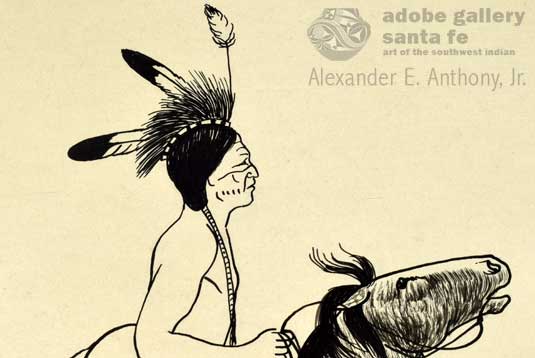Original Painting of Plains Indians on Horseback [SOLD]
+ Add to my watchlist Forward to Friend
- Category: Paintings
- Origin: Zia Pueblo, Tsi-ya
- Medium: watercolor
- Size:
12-1/2" by 17-7/8" image;
15-1/4” x 20-3/4” framed - Item # C4155J SOLD
Velino Shije Herrera (1902-1973) Ma Pe Wi (Oriole) was a Zia Pueblo painter who is regarded as one of the earliest known Rio Grande pueblo painters. Crescencio Martinez of San Ildefonso Pueblo was, by most accounts, the earliest of the pueblo easel artists. He passed away in 1918, long before pueblo easel art was recognized as existing. He was followed by four young pueblo men who essentially constitute the first artists to produce paintings for sale. The four were Martinez's nephew Awa Tsireh , Hopi artists Fred Kabotie and Otis Polelonema, and Velino Herrera. These artists became very productive around 1918, feeding off each other's enthusiasm. Dr. Edgar Lee Hewitt, Director of the Museum of New Mexico, arranged for the four young men to work at the museum in 1920. Famous New Mexicans Alice Corbin Henderson, Mary Austin, and Mabel Dodge Luhan were instrumental in finding outlets for the works of these artists. They purchased their paintings and found others to purchase them as well.
In 1919, Elizabeth DeHuff, wife of the newly-appointed superintendent of the Santa Fe Indian School, arranged an exhibit of the art of the Indian School students. DeHuff canvassed the classes to find students who excelled in paintings and drawings. She stated "Two boys showed early marks of genius: a Zia Pueblo boy, Velino Shije (later Herrera), in a primary grade whom the teacher complained drew animals and faces upon all the papers she gave to him for school work; and a Hopi boy, Fred Kabotie, who would forget what he was doing when he had sawed half through a board in the carpenter's shop and intently draw figures on its surface... One could not learn, the other would never be a carpenter, so they might just as well be occupied elsewhere." (Brody 1997)
At the age of 20 years, Herrera’s painting technique had improved tremendously and his works showed great confidence and control. He was applying colors in complementary tones and could exhibit perspective in his works. Ethnographic accuracy was important to Herrera and his paintings were strong in that regard. Clara Lee Tanner’s Southwest Indian Painting: A Changing Art praised Herrera’s skill and versatility: “Watercolor, Shiva, tempera and oils, all have been mastered by Velino Herrera. He has painted murals in homes and in public buildings; particular mention should be made of his fine work in the Department of the Interior, Washington, D.C. His work is done in a flat style, or with a little shading, or in full perspective. Full realism to abstract painting were developed by Ma-Pe-Wi, frequently the two styles appear in the same picture.” Today, his paintings are considered to be quite collectible, because of his historical significance and the quality of his work.
This particular Ma Pe Wi image is unlike any of his works that we’ve handled in the past. Here, the artist used only black paint on cream-colored paper to create an excellent depiction of four Native American men on horseback. It’s a strong, striking image that benefits greatly from Ma Pe Wi’s bold and unusual decision to work only with black paint. The four men and their horses are pictured in motion, positioned in two rows of two. One of the men in the front row points directly ahead of the party. The men are depicted in a unique style that might have been impossible had a variety of colors been used. Their faces, their muscular bodies, and their elaborate Plains Indian headdresses somehow seem even more remarkable when presented in stark black-on-white. Their horses—one of Ma Pe Wi’s strengths, according to Tanner’s book—are excellent, too. This exceptionally powerful image from one of the earliest pueblo painters will delight collectors who appreciate rare and unusual compositional choices.
 The painting is signed “Ma-Pe-Wi” in its lower right corner. It is framed beautifully, underneath a thin black matte. The frame itself—a thin wood frame with gold, black and red bands—appears to be original and is the style used on paintings in the famous place for lodging in Santa Fe, the La Fonda Hotel, in the 1920s. Its strong colors improve an already excellent presentation.
The painting is signed “Ma-Pe-Wi” in its lower right corner. It is framed beautifully, underneath a thin black matte. The frame itself—a thin wood frame with gold, black and red bands—appears to be original and is the style used on paintings in the famous place for lodging in Santa Fe, the La Fonda Hotel, in the 1920s. Its strong colors improve an already excellent presentation.
Condition: good condition with a few minor stains and imperfections
Provenance: this Original Painting of Plains Indians on Horseback is from the large collection of a New York resident.
Recommended Reading: Pueblo Indian Painting: Tradition and Modernism in New Mexico, 1900-1930 by J.J. Brody

- Category: Paintings
- Origin: Zia Pueblo, Tsi-ya
- Medium: watercolor
- Size:
12-1/2" by 17-7/8" image;
15-1/4” x 20-3/4” framed - Item # C4155J SOLD



